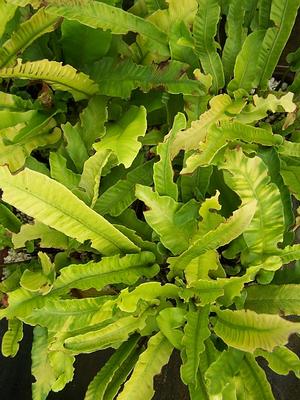View All Plants :: View All FERNS :: View All SHADE PERENNIALS
Phyllitis scolopendrium
Hart's Tongue Fern
Plant Type:
FERNSPhyllitis scolopendrium (syn. Asplenium scolopendrium) – Hart's Tongue Fern with its leathery bright green, irregular glossy fronds appears to be almost other wordly. Each virtually evergreen frond stretches 8 to 12 inches long by 2 to 3 inches wide. Site in part to dappled sun in fertile, moisture retaining soil. Phyllitis scolopendrium will benefit from the addition of dolomitic limestone to the planting hole. The species is found in Ireland, Britain to North Africa, Eurasia, east to Japan... I may have missed some locales! Spring planting may be the wiser tact for gardeners towards the northern end of its range. Please scroll down to the Genus Overview for more information about ferns. Established pot grown fern from division.
Characteristics and Attributes for Phyllitis scolopendrium
Season of Interest (Foliage)
- Spring / Summer / Autumn / into Winter
Nature Attraction
- Deer Resistant
Light
- Dappled Shade
- Morning Sun / Afternoon Shade
- Shade
Attributes
- Wildlife Garden
- Natural Garden
- Border
- Accent
- Foliage
- Potted Plant
- Marginal
- Massing
- Woodland
- Labyrinth
Growth Rate in the Garden
- Slow
Soil
- Fertile
- Moist
- Calcareous
Origins
- Great Britain
- Japan
- Eurasia
- North Africa
Propagated By
- Spore
- Division
Genus Overview: Ferns
Ferns. The easy, elegant and exceptional beauty of ferns cannot be understated. All ferns, beautiful as specimens unto themselves, are extraordinary in their simple ability to provide rich contrast to other companions wherever their requirements befit.
Habituated to so many environments many of the ferny pteridophytes – vascular plants that reproduce by spores, not seeds - are woodland denizens thriving on the cool, damp forest floor like the Christmas Fern, Polystichum acrostochoides with some preferring the wetter disposition of bogs, swamps, and stream banks such as Osmunda cinnamomea. Others will colonize gritty soils in shade or sun like the running Hay-scented fern, Dennstaedtia punctilobula and many among the Cheilanthes. Some are tough enough to grasp a foothold in the crack of a rock, these are lithophytic, as with Asplenium trichomanes. And some – most of these tropical in origin are truly epiphytic, clinging to tree bark as they unfurl their fronds from embryonic croziers to reach into the forest light such as the primitive looking Staghorn Fern, Platycerium bifurcatum or Rabbit-foot Fern, Davallia fejeensis .
And many have historic medicinal uses such as Maidenhair Fern, Adiantum pedtaum – this from medicinalherbinfor.org, “Expectorant, anti-rheumatic, demulcent, pectoral, refrigerant, tonic”... Native Americans throughout North America used maidenhair as a hair wash to make their hair shiny.” And in a more Bacchanalian use: as a flavoring in liquers.
There was probably something fern-like, an ancient ferny forebear(s) if you will, living during the Devonian some 60 to 70 million years ago. Ferns, some we still recognize today are descendents from an ancient order whose reign during the Carboniferous Age is legend, where giant horsetails and monstrous club mosses still populate the misty recesses of our dreams... and whose contemporary plundering by Homo sapiens in the vast burning of fossil fuels is altering our climate at such an alarming rate that more among the many are beginning to query as to the potential for another mass extinction – the closing chapter of another age, a blip in the larger context of perceived time. But I digress....
All our offerings are well-rooted pot grown divisions in 5 pint squares unless otherwise indicated. The quality we offer make them worth the money. We think you will agree.
